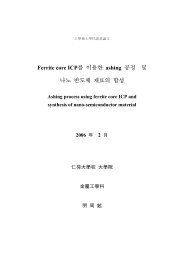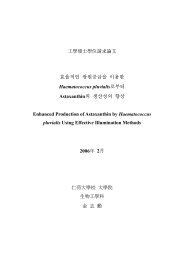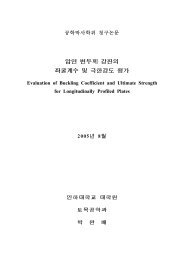저작자표시-비영리-변경금지 2.0 대한민국 이용자는 아래의 조건을 ...
저작자표시-비영리-변경금지 2.0 대한민국 이용자는 아래의 조건을 ...
저작자표시-비영리-변경금지 2.0 대한민국 이용자는 아래의 조건을 ...
You also want an ePaper? Increase the reach of your titles
YUMPU automatically turns print PDFs into web optimized ePapers that Google loves.
SECTION II. Preparation and Characterization of PBS/Carbon<br />
Nanofiber Nanocomposite Foams<br />
1. Introduction<br />
Polymeric foams are the lightweight materials containing gaseous<br />
voids by means of physical and chemical blowing agents, which have<br />
been mainly used in the insulation, absorbents, cushion, packaging<br />
and weight-bearing structures. [1] For the polymer nanocomposite<br />
foams, the integration of the small amounts of nano-sized fillers into<br />
the virgin polymer may provide enhanced thermal stability and<br />
mechanical properties compared to those of the neat polymer foam,<br />
and can effectively induce the nucleation of a large amount of bubbles<br />
according to the geometry of the added-nanoparticles. [2]<br />
In order to reduce the environmental problems caused by the non-<br />
degradable plastics, the development of the biodegradable polymers<br />
with the properties enough to compare with those of the commodity<br />
plastics greatly have been required and steadily studied by extensive<br />
research groups. Poly(butylene succinate) (PBS), one of the most<br />
applied biodegradable plastics to the scientific and industrial fields, is a<br />
26







